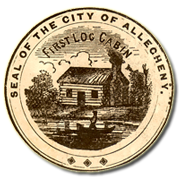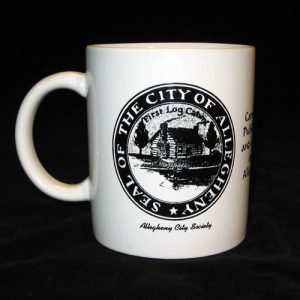Link to Doug Suisman’s Post Gazette article: “Reviving the North Side’s ‘Lost City'”
North Side: A Day in Old Allegheny
By Frederick P. Mayer in the Pittsburgh Record, June 1930.
One of my regrets as a resident of Allegheny City has always been that I have known it only in the days when its glory was already gone. I am not speaking, in this gloomy vein, of the North Side, which everybody admits is a prosperous modern community, but I am writing, as an Alleghenian, of that small, relatively flat stretch of business buildings, parks, and dwelling houses that composed Old Allegheny, limited on one extremity by Dutchtown, on another by Federal Street hill, on another by “Old Chester,” and, on the fourth, by the river.
Family albums, old newspapers I read instead of Milne’s Algebra on idle afternoons in the Carnegie Free Library of Allegheny, reminiscent relatives, and my childhood recollections of the town in which I was born, form a tissue, mainly romantic, of a life which I never reallly knew. For this reason, from books that I run upon in second hand stores and in guileless friends’ libraries, I have gathered impressions of what Allegheny City life was in the days, let us say, of the spring of 1895, a year which, if not significant in itself, stands for a period when Allegheny felt its importance, and looked ahead–how romantically wrong only a person of today can know!–to a shining and independent future. Here, then, is something of what the town must have been like in those hopeful (I almost said “Halcyon”) days of ninety-five.
There was a flood of yellow light across the parks that spring morning in 1895, but to the 118,000 citizens of Allegheny, it was just another Monday.
Even then, the large red brick and stone residences of the wealthy raised elegant if somewhat ugly roofs above the tracery of old trees on Ridge Avenue and North and Sherman. Yet, in the warm light and beyond iron dogs and ornamental fences, the lawns were well trimmed, the door knobs and hinges shone like gold from the polishings of German maids, and chance views of front parlors, seen through opened windows as the lace curtains fluttered back (it was still too early to be “proper” time to take down the winter “drapes), suggested that calm content and sublime faith in a beneficent universe that money in the bank and large dinners on Sunday tables developed in the well-to-do.
The hard times of ’93-’94 were not forgotten, to be sure. A dancing platform had been made into a dormitory for nearly 200 men, and its frame sides still stood, a bleak reminder of the “slump,” and the city department of charity expended $58,000 for the needy–and the plentiful–poor. Yet, there were signs of a business revival. The new high school building on Sherman Avenue had been built, tower, marble halls, and all, at the staggering figure of $150,000, and students in the last school year numbered 502, which showed that not every family found it necessary to make the children go to work.
But there were better signs of prosperity. Across Ober Park, the post office rose, new and gleaming, its gold leaf dome dazzling in the sun, and its receipts for the year were about $100,000. There was, as well, the cheerful buzz of electric cars, four-wheeled. erratic, and exciting, except when the trolley jumped its wire and left the riders dreaming of the dependability of the rejected horse, or when the trolley ran ahead on Federal Street, running down the hill from the University. Then the motorman swore ecstatically, and the student riders cheered.
Competition was the life of the trolley car business, or, perhaps, in the light of modern theories of consolidation, its death. But the Federal Street Company flourished, with 75 cars and 35,000 riders in one day, and the Pittsburgh, Allegheny, and Manchester line ran 76 cars, with 58,000 riders in 20 hours, and the Allegheny Traction Company, with 20 miles of shining track, began its collection of nickels in October of ’94.
But the electricity lighted, as well as moved, old Allegheny. An ill-fated experiment with high mast lighting proved wasteful, so that the city was soon dotted with yellow clay holes for newer, shorter poles.
The high masts remained for many years in the parks, lighting the trees and the sky and leaving the dangerous paths dark beneath them. The idea for such lighting, imported from Detroit, was widely advertised as a modern advance; but actually, in the streets, the high lighting shed only a vague glow, furnishing more brilliance for nocturnal cats on house roofs than it did guidance to walkers after dark. The merchants complained, the housewives feared the dangers of robbery, and public opinion finally took the poles away. Then came the modern style of city lighting, which, with a few improvements, persists to the present day, except that the pole climber who used to replace burned-out carbons has, these days, lost his old importance.
The year before, the Allegheny City Electric Power Plant had spent $51,239.44 on enlarging its equipment and made night life safe and, at the same time, alluring by 600 arc, 3,000 alternating incandescent, and 1,000 direct current lamps.
Telephones, rattling in the users’ ears and going blank, at times, from nervous exhaustion over increased business, were neither uncommon nor, on the other hand, democratically cheap. A house ‘phone?…for the Mayor, perhaps, and one for the fire chief, and a few in the mansions on the Park…but not for the average man! Orders by ‘phone to Arbuckle’s or to the Commercial Gazette or calls from bank to bank were carried by the Central District and Printing Telegraph Company, which sold its services at $84.00 for one year. Rumors of a rival company, to operate at half-fare, troubled the financial security of those business men whose efforts had made possible the first organization.
Electricity helped citizens climb the hills. The Nunnery Hill Inclined Plane, with 1,100 feet of track, which began at upper Federal Street; the Troy Hill Inclined Plane, 370 feet long; and the Clifton Inclined Plane, which rose from Irwin Avenue and Brighton Road, scaled the sandy heights to the outlying districts.
Already the suburbs were developing. The twisted paths of Riverview Park, with their glimpses of the distant blue Ohio, had been opened for the delights of family picnics, at which, around piles of lieberwurst sandwiches and pickles and bottles of lager beer, the young cousins could meet and quarrel in domestic amity and the uncles and aunts could speculate on the capacities of the new preacher and the future of the tanning business on the Allegheny river banks. Perrysville Avenue led to the Park, its first paving scarcely hard, and Marshall Avenue had been widened to 60 feet. Bellevue, that nearly mythical community which pulled its citizens up the river bank from the trains to its unharried, peaceful lanes, was now the end of one branch of the Pleasant Valley Street Railway Company, and began expanding, while it boasted of sewers, lights, and graded streets. Beyond it lay obscure Ben Avon, rustically asleep and glad of it, promising no sewers, no factories–and wanting neither.
City life, although on a small scale, had already met and embraced sophistication. Bicycles menaced the pedestrian, for they were faster, more unstable, and less domesticated than horses. Gripped by unsteady hands, they might run anywhere, and did–between the legs of substantial citizens and into the arms of the unwary police. Lodges took the dignified man of business into that land of mysterious brotherhood and informality that was later to blossom with the genial spirit of Rotary, while libraries (the Citizens Free Library fell not before the munificent competition of Andrew Carnegie) offered the studious a variety of “serious” reading–novels had still the connotation of frivolity.
Variety in the interpretation of local news was afforded by a number of independent newspapers among which I recall Alexander Moore’s Leader (“not controlled by Politicians” and “Absolutely Independent in everything”). In the morning, at Allegheny breakfasts of scrapple and pie, the Commercial Gazette told all, and for one cent.
Life, in 1895, from the stories of survivors, must have been full of parties and entertainments. Money, on Ridge Avenue, was made and spent freely, and the social season lasted nearly all summer long, for the exodus to Europe had not yet begun. Concerts and lectures on the rigors of foreign travel, helped to fill the dark winter nights. Dancing flourished, for schools of the dance were numerous. Allegheny had one theatre, the New World’s Museum, on lower Federal Street, but Pittsburgh’s theatres, especially the Alvin were not far off. And in the chilly wet days of fall, when winter swept the valley with mists and snows and great blankets of sooty fog, the new Exposition Building at the Point drew its crowds, who, chewing hard candy and peanuts, tramped the stone floors to see Heinz pickles packed under their very eyes, Horne’s coats and dresses displayed in brilliant cases, and Heeren’s diamonds cut and set while they watched. In those great halls one could find his neighbors having their pictures taken, see new styles of warm air furnaces, look at pictures in the art galleries, or sit down, tired and chilly, in the Auditorium, and listen to Innes’s, Gilmore’s, or the Seventh Regimental Band of New York. Thoughts of the Exposition lasted all year round, and brightened the yellow light of spring because the Exposition made attractive even dirty autumn weeks.
So passed the days of Allegheny’s freedom, days that now resemble those of Indian summer, since the sudden winter of consolidation lay so near and yet so unexpected. (It is worth the time of anyone who wishes to understand the civic spirit of the present North Side to reflect that Allegheny rejected a “metropolitan plan” in 1867 and has never since felt quite honestly dealt with in the later consolidation of the early 1900s.) Allegheny’s sunny days of independence and importance swiftly passed, like the glory of the Exposition itself, which now–its windows smashed and the columns of its Music Hall defaced by time–reeks with the fumes of gasoline and trembles with the rumble of grinding city trucks.
Yet, on sunny days, the old houses on the Park take on their quiet beauty, and the side lawns, still neatly trimmed, are shadowed by the leaves of their peaceful trees. A sudden fashion for town houses like those on Washington Square may bring back the glory of this old place where wealth was once mixed with decorum and where city life, although busy, was not unlovely…at least, to my modern eyes.
Willard Glazier. “Pittsburg.” Chap. in Peculiarities of American Cities.
Philadelphia: Hubbard Brothers, Publishers, 1885
Allegheny City.
Pittsburg has no park or public pleasure ground. Its people are too busy to think about such things, or to use them if it had them. On Saturday nights its theatres and variety halls are crowded, to listen to entertainments which are not always of the best. When its people wish to visit a public park, they must cross to Allegheny City, on the west bank of the Allegheny River, where there is a park embracing a hundred acres, containing a monument to Humboldlt, and ornamented with small lakes. The Soldiers’ Monument, erected to the memory of four thousand men of Allegheny County who lost their lives in the war of the Rebellion, is also in this latter city, on a lofty hill near the river, in the eastern part of the city. Many of the handsome residences of Pittsburg’s merchants and manufacturers are to be seen in this city, which is also famous for its manufacturing interests, and is connected with Pittsburg by five bridges. Birmingham is a flourishing suburb on the opposite bank of the Monongahela River, containing important glass and iron manufactories.





